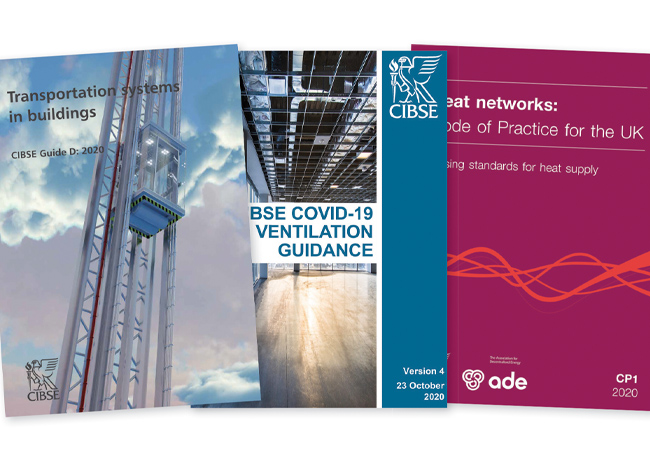
Volunteers from CIBSE’s Special Interest Groups (SIGs) have spent the past 12 months navigating the Covid-19 crisis with a combination of resilience, intelligence and technical expertise.
As well as publishing key guides on reducing the risk of Covid-19 in the built environment, they have also had to manage the migration online of committee meetings and technical discussions.
The SIGs contribute towards research and knowledge in specialist areas of the built environment, for the benefit of CIBSE members and beyond.
All have a common objective: to improve the built environment, with a focus on the sustainability and health and wellbeing of buildings.
The industrious work carried out by these volunteers justifies their status as the unsung heroes of CIBSE.
One early adopter of online meetings was the Intelligent Buildings Group (IBG), which aims to help built environment specialists use intelligence (in systems, scope or design) to realise buildings with ‘high social, environmental and economic objectives’.
Professor Derek Clements-Croome’s monograph on Designing buildings for people: sustainable liveable architecture was published in June 2020. This work typified the IBG’s approach to transdisciplinary research, and it has collaborated with designers, architects, planners, digital sociologists and many others.
Online seminars have been held on intelligent buildings post-Covid, intelligent campuses, biophilic design, and the fourth industrial revolution.
Other groups have been working to minimise the disruption caused by the pandemic.
The Energy Performance Group, chaired by Roger Macklin, has migrated online its popular ‘Power hour’ sessions, in which speakers give speed presentations on topics such as carbon offsetting, responsible refurbishment, low carbon heat networks, and energy use under Covid-19.
The Young Energy Performance Group delivered a series of CPD sessions and podcast series on energy efficiency, the future of building services and other topics for engineers at the start of their careers.
High-calibre technical guidance has also flourished despite the pandemic, and, in many cases, has been led by the group volunteers.
Among the most ambitious technical outputs has been that of the Lifts Group, which published a comprehensive revision of Guide D: Transportation systems in buildings in 2020, overseen by Dr Gina Barney, group chair. First issued in 1993, this document has been revised on a five-year cycle to cover the latest developments in the design, installation and safe usage of mechanical transportation in buildings.
Also impressive has been the update of Heat networks: Code of Practice for the UK (CP1), carried out with substantive contributions by the CHP and District Heating Group, with chair Phil Jones as lead author.
This thorough revision incorporates much of the latest research and practice in the field, and will be particularly pertinent for local and central government implementation of heat networks, especially in the pursuit of net zero.
In many respects, the headlines should belong to the groups that have most contributed to our understanding of the Covid-19 pandemic and the built environment.
The Healthcare Group has led the way in informing members and industry practitioners about transmission risks of airborne pathogens, in healthcare premises and other buildings.
The publication of an informative note on emergency HVAC measures was welcomed by members, while Health Technical Memorandum 03 has been widely used throughout the pandemic and is currently being revised.
Chair Francis Mills has presented the findings of these publications, and Healthcare Group publications have been referenced by government advisory group SAGE.
The Natural Ventilation and HVAC Systems groups, with support from the Facilities Management and Lifts groups, have been responsible for three publications to help the industry navigate the pandemic, producing and updating the Covid-19 guidance documents on Emerging from lockdown: safely re-occupying buildings, Recommissioning of lifts and escalators and Ventilation guidance.
The healthcare sector has also been central to the work of the Heritage Group.
CIBSE’s oldest group produced a series of newsletters looking at the history of the healthcare system in Britain, celebrating the nurses and doctors who have worked tirelessly throughout the pandemic, while looking at the contributions of engineers in the field.
Other substantial pieces of work include the CIBSE Heritage calendar, a study of the Gurney Stove by member Paul Yunnie, and the consolidation of the CIBSE Heritage catalogue in Cardiff University library.
Roisin Sweeney, CIBSE head of membership services, thanked the volunteers for their unrelenting efforts: ‘The sheer amount of output from the CIBSE Groups is impressive and the quality of the activity is inspiring. We are very proud of our volunteers who make all this possible, especially given the extra challenges faced over the last year. Thank you doesn’t come close to the gratitude you deserve – we couldn’t do it without you.’
For help locating any of the resources in this article, email groups@cibse.org. Members and non-members can join any of the CIBSE Groups for free through the MyCIBSE portal.
- Report written by Julian Jones, senior membership services coordinator, CIBSE
